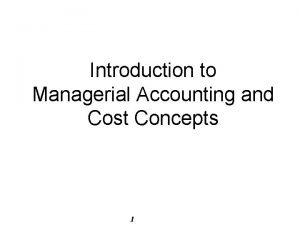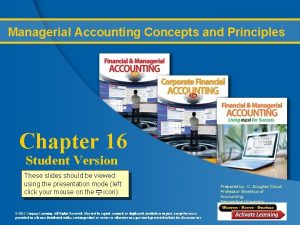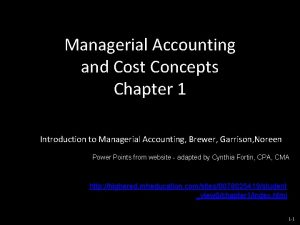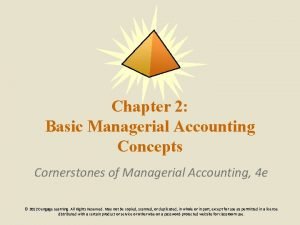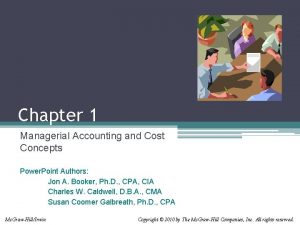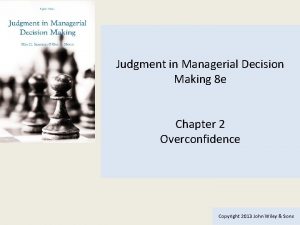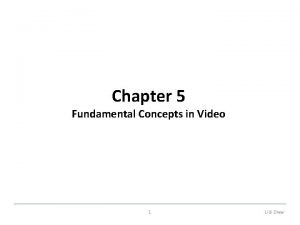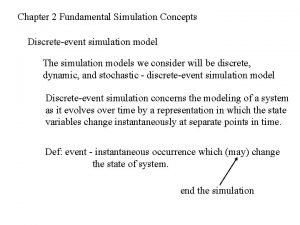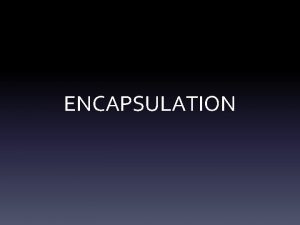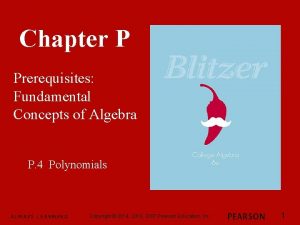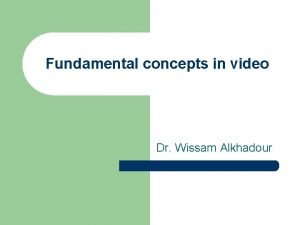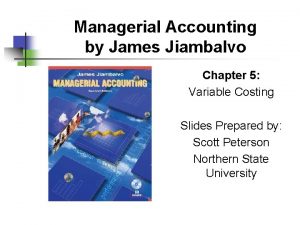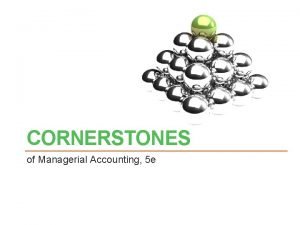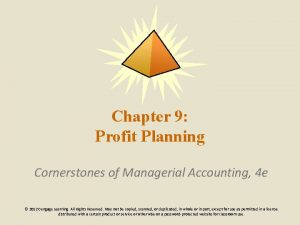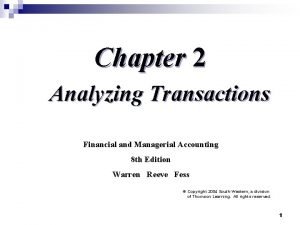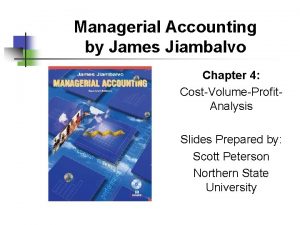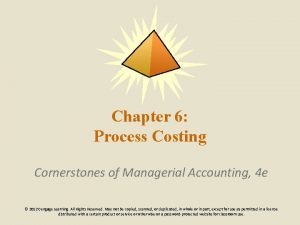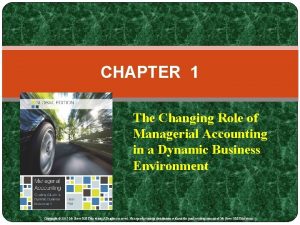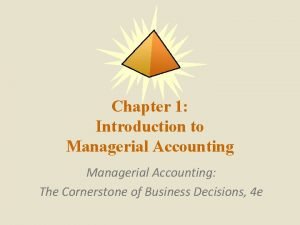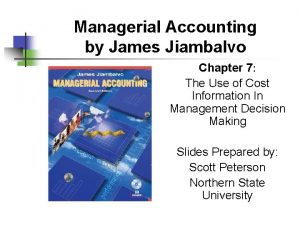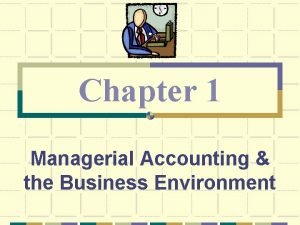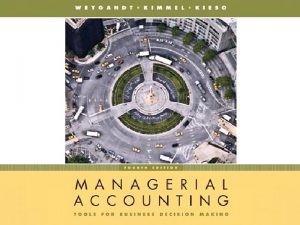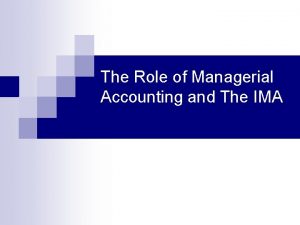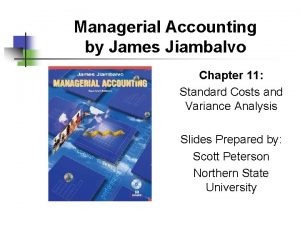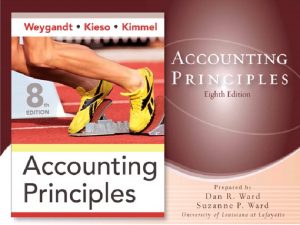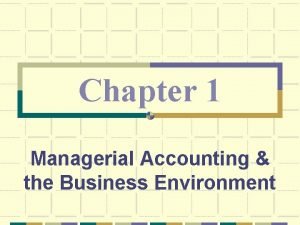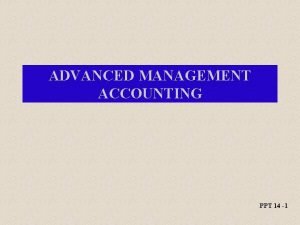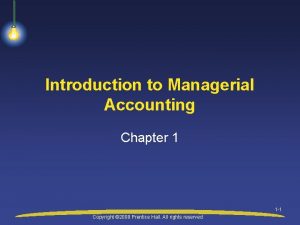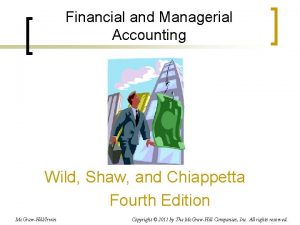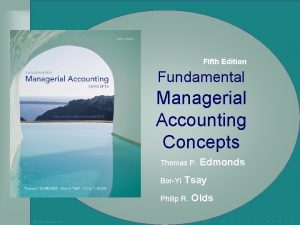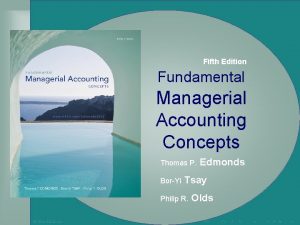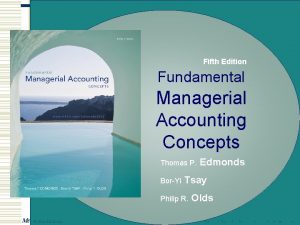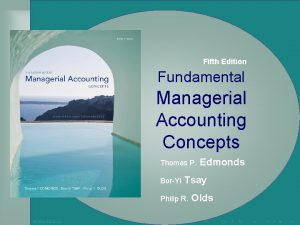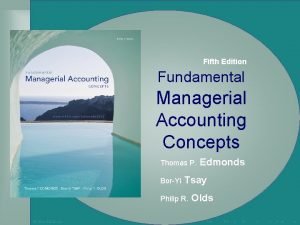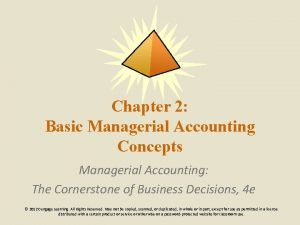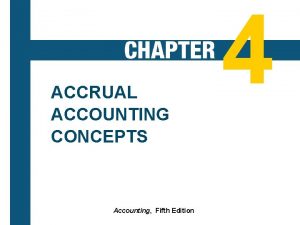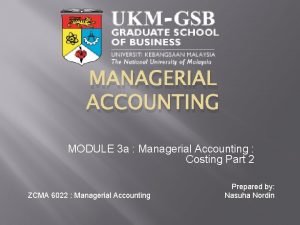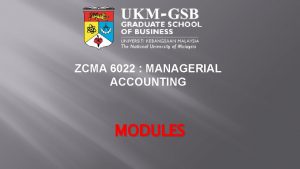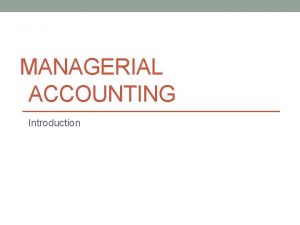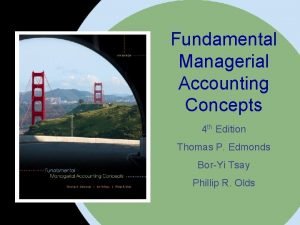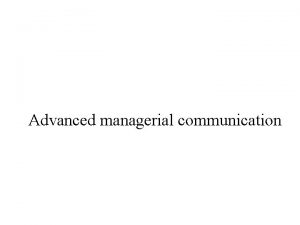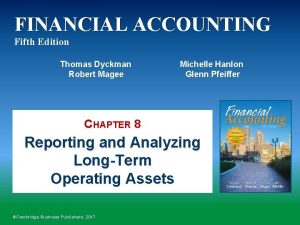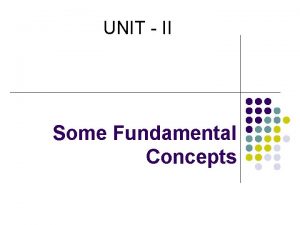Fifth Edition Fundamental Managerial Accounting Concepts Thomas P



















































- Slides: 51

Fifth Edition Fundamental Managerial Accounting Concepts Thomas P. Bor-Yi Tsay Philip R. Mc. Graw-Hill/Irwin Edmonds Olds 4 -1 Copyright © 2009 by The Mc. Graw-Hill Companies, Inc. All rights reserved.

CHAPTER 4 Cost Accumulation, Tracing, and Allocation 4 -2

Chapter Opening What does it cost? Managers must have reliable cost estimates to: • Price products. • Evaluate performance. • Control operations. • Prepare financial statements. 4 -3

Learning Objective Identify cost objects and cost drivers. LO 1 4 -4

Determine the Cost of Cost Objects A cost object is any activity, product, or service to which accountants wish to trace costs. Cost accumulation begins with identifying: 1. Cost objects 2. Cost drivers 4 -5

Use of Cost Drivers to Accumulate Costs Units produced Machine hours A cost driver is any factor that causes or “drives” an activity’s costs Miles driven Labor hours 4 -6

Use of Cost Drivers to Accumulate Costs Total Long Distance Telephone Bill Accumulated Cost Minutes Talked = ´ Rate per Minutes talked is the cost driver. Minutes Talked 4 -7

Estimated Versus Actual Cost Timely Relevant Potential Inaccuracies Estimated Costs Managers use estimated costs to make decisions about the future. 4 -8

Learning Objective Distinguish direct costs from indirect costs. LO 2 4 -9

Identifying Direct and Indirect Costs In Style, Inc. Department Store pays a bonus to each department manager based on departmental sales. The incentive has increased departmental sales, but departmental profits have not increased accordingly. Management has decided to base future bonuses on department profitability. 4 -10

Identifying Direct and Indirect Costs The first step in the development of the new bonus strategy is to determine the costs of each department. Costs that can be traced to departments in a cost-effective manner are called direct costs. Costs that cannot be traced to departments in a cost-effective manner are called indirect costs. 4 -11

Identifying Direct and Indirect Costs 4 -12

Learning Objective Allocate indirect costs to cost objects. LO 3 4 -13

Allocating Indirect Costs to Departments Identify the most appropriate cost driver for each indirect cost. Indirect costs should be allocated to reflect how the departments consume resources. The cost drivers of In Style, Inc. are: 4 -14

Allocating Indirect Costs to Departments Use a two-step process to allocate indirect costs: Allocation rate = total cost ÷ cost driver activity. Allocated cost = allocation rate × weight of the cost driver activity. 4 -15

Allocating Indirect Costs to Departments $9, 360 ÷ 3 departments = $3, 120 per department $3, 120 × 1 department = $3, 120 4 -16

Allocating Indirect Costs to Departments $18, 400 ÷ 23, 000 square feet = $0. 80 per square foot $0. 80 × 12, 000 Women’s square feet = $9, 600 $0. 80 × 7, 000 Men’s square feet = $5, 600 $0. 80 × 4, 000 Children’s square feet = $3, 200 4 -17

Allocating Indirect Costs to Departments $2, 300 ÷ 23, 000 square feet = $0. 10 per square foot $0. 10 × 12, 000 Women’s square feet = $1, 200 $0. 10 × 7, 000 Men’s square feet = $700 $0. 10 × 4, 000 Children’s square feet = $400 4 -18

Allocating Indirect Costs to Departments $7, 200 ÷ $360, 000 sales = $0. 02 per sales dollar $0. 02 × $190, 000 Women’s sales = $3, 800 $0. 02 × $110, 000 Men’s sales = $2, 200 $0. 02 × $60, 000 Children’s sales = $1, 200 4 -19

Allocating Indirect Costs to Departments $900 ÷ $360, 000 sales = $0. 0025 per sales dollar $0. 0025 × $190, 000 Women’s sales = $475 $0. 0025 × $110, 000 Men’s sales = $275 $0. 0025 × $60, 000 Children’s sales = $150 4 -20

Allocating Indirect Costs to Departments 4 -21

Learning Objective Select appropriate cost drivers for allocating indirect costs. LO 4 4 -22

Using Volume Measures to Allocate Variable Overhead Costs Increases in the volume of production will cause variable overhead costs to increase. Volume measures serve as good cost drivers for the allocation of variable overhead. Units Produced Labor Hours Materials Used 4 -23

Using Volume Measures to Allocate Variable Overhead Costs Filmier Furniture Company Production and Cost Information Use the two-step process to allocate indirect materials cost using the three volume measures as cost drivers. 4 -24

Using Volume Measures to Allocate Variable Overhead Costs $60, 000 ÷ 5, 000 units = $12 per unit × 4, 000 chairs = $48, 000 $12 per unit × 1, 000 desks = $12, 000 4 -25

Using Volume Measures to Allocate Variable Overhead Costs $60, 000 ÷ 6, 000 hours = $10 per hour × 3, 500 hours = $35, 000 $10 per hour × 2, 500 hours = $25, 000 4 -26

Using Volume Measures to Allocate Variable Overhead Costs $60, 000 ÷ $1, 500, 000 of direct material = $0. 04 per dollar of direct material $0. 04 per $ × $1, 000 = $40, 000 $0. 04 per $ × $500, 000 = $20, 000 4 -27

Selecting the Best Cost Driver So which volume measure should I use? Judgment and reasoning are necessary. Considerations Relationship between cost driver activity and use of resources. Availability of information. 4 -28

Allocating Fixed Overhead Costs Objective Distribute a fair share of the overhead cost to each product. There are no volume based cost drivers for fixed overhead. 4 -29

Allocating Fixed Overhead Costs Lednicky Bottling Company Information Use the two-step process to allocate the fixed rental cost to units sold and to units in ending inventory. 4 -30

Allocating Fixed Overhead Costs $28, 000 ÷ 2, 000 units = $0. 014 per unit × 1, 800, 000 units = $25, 200 $0. 014 per unit × 200, 000 units = $2, 800 4 -31

Learning Objective Allocate costs to solve timing problems. LO 5 4 -32

Allocating Costs to Solve Timing Problems Allocating fixed costs can be complicated when the volume of production varies from month to month. If prices are based on these costs, units produced in January will be priced higher than those produced in February. Will customers think this is reasonable? 4 -33

Allocating Costs to Solve Timing Problems We solve this problem by using estimated costs and estimated production for the year to obtain a predetermined overhead rate (POHR). POHR = Estimated overhead for the year Estimated allocation base for the year $36, 000 18, 000 units = $2. 00 per unit $2. 00 allocated to each unit produced for all months during the year. 4 -34

Learning Objective Explain the benefits and detriments of allocating pooled costs. LO 6 4 -35

Aggregating and Disaggregating Individual Costs into Cost Pools Gas Water Frequently, companies accumulate many individual costs into a single cost pool. Electricity Utilities Cost Pooling should be limited to costs with common cost drivers. 4 -36

Learning Objective Allocate joint product costs. LO 7 4 -37

Allocating Joint Costs Product Joint products – products resulting from a process with a common input. Split-off point – the stage of processing where joint products are separated. Joint costs – costs of processing joint products prior to the split-off point. 4 -38

Allocating Joint Costs Joint Input Oil Common Production Process Final Sale Separate Processing Costs Gasoline Split-Off Point Separate Processing Final Sale Separate Processing Costs 4 -39

Relative Sales Value Method Joint conversion cost = $225, 000 Joint material cost = $275, 000 Oil $200, 000 sales value at split-off point Gasoline $600, 000 sales value at split-off point Common Production Process Split-Off Point 4 -40

Relative Sales Value Method 4 -41

Relative Sales Value Method $225, 000 joint conversion cost plus $275, 000 joint material cost 4 -42

Learning Objective Recognize the effects of cost allocation on employee motivation. LO 8 4 -43

Cost Allocation: The Human Factor Is it fair to divide the College of Business’s copy budget equally? I think we should consider the number of students. I think we should consider the number of faculty. 4 -44

Cost Allocation: The Human Factor Let’s see how the allocation of budgeted amounts will effect the different departments. We will begin by allocating based on the number of faculty in each department. 4 -45

$36, 000 ÷ 72 faculty = $500 per faculty member $500 × 29 faculty members = $14, 500 Who is happy? Who is unhappy? $500 × 16 faculty members = $8, 000 $500 × 12 faculty members = $6, 000 $500 × 15 faculty members = $7, 500 Now let’s allocate the $36, 000 budget based on the number of students in each department. 4 -46

$36, 000 ÷ 1, 200 students = $30 per student × 330 students = $9, 900 Who is happy? Who is unhappy? $30 per student × 360 students = $10, 800 $30 per student × 290 students = $8, 700 $30 per student × 220 students = $6, 600 4 -47

Learning Objective Allocate service department costs to operating departments. (Appendix) LO 9 4 -48

Allocating Service Center Costs – Direct Method Personnel Service Department Secretarial Service Department First-stage Allocations Civil Operating Department Criminal Operating Department Cases Second-stage Allocations 4 -49

Allocating Service Center Costs – Step Method Personnel Service Department Secretarial Service Department Civil Operating Department Criminal Operating Department Cases First-stage Allocations Second-stage Allocations 4 -50

End of Chapter 4 4 -51
 Basic concept of managerial economics
Basic concept of managerial economics Equi marginal principle in managerial economics
Equi marginal principle in managerial economics Managerial accounting basics
Managerial accounting basics Accounting principles and concepts
Accounting principles and concepts Accounting principles and concepts
Accounting principles and concepts Basic managerial accounting concepts
Basic managerial accounting concepts Chapter 1 managerial accounting and cost concepts
Chapter 1 managerial accounting and cost concepts Principles of marketing fifth european edition
Principles of marketing fifth european edition Ciccarelli 5th edition
Ciccarelli 5th edition Fundamentals of corporate finance fifth edition
Fundamentals of corporate finance fifth edition Democritus atomic model diagram
Democritus atomic model diagram Mitosis
Mitosis Molecular biology
Molecular biology Human anatomy fifth edition
Human anatomy fifth edition Human anatomy fifth edition
Human anatomy fifth edition Fifth step of accounting cycle
Fifth step of accounting cycle Managerial economics 12th edition mark hirschey
Managerial economics 12th edition mark hirschey Judgement in managerial decision making
Judgement in managerial decision making Fundamental concepts in video
Fundamental concepts in video Fundamental simulation concepts
Fundamental simulation concepts Sociolinguistics examples
Sociolinguistics examples Four fundamental oop concepts
Four fundamental oop concepts Prerequisites fundamental concepts of algebra
Prerequisites fundamental concepts of algebra Chapter p prerequisites fundamental concepts of algebra
Chapter p prerequisites fundamental concepts of algebra Chapter p prerequisites fundamental concepts of algebra
Chapter p prerequisites fundamental concepts of algebra Fundamental concepts of bioinformatics
Fundamental concepts of bioinformatics Ssef price list
Ssef price list Fundamental and powerful concepts
Fundamental and powerful concepts Fundamental concepts in video
Fundamental concepts in video Scope of mgt accounting
Scope of mgt accounting Managerial accounting chapter 5 solutions
Managerial accounting chapter 5 solutions Managerial accounting chapter 13 solutions
Managerial accounting chapter 13 solutions Managerial accounting chapter 9
Managerial accounting chapter 9 Managerial accounting chapter 2 solutions
Managerial accounting chapter 2 solutions Jiambalvo managerial accounting
Jiambalvo managerial accounting Managerial accounting chapter 6
Managerial accounting chapter 6 Role of managerial accounting
Role of managerial accounting Chapter 1 managerial accounting
Chapter 1 managerial accounting Cost of goods manufactured formula
Cost of goods manufactured formula Managerial accounting chapter 7
Managerial accounting chapter 7 Managerial accounting and the business environment
Managerial accounting and the business environment Chapter 1 managerial accounting
Chapter 1 managerial accounting Managerial accounting
Managerial accounting Managerial accounting james jiambalvo
Managerial accounting james jiambalvo Accounting nature and scope
Accounting nature and scope Cost theory and estimation
Cost theory and estimation Distinguishing features of managerial accounting
Distinguishing features of managerial accounting Distinguishing features of managerial accounting
Distinguishing features of managerial accounting Managerial accounting and the business environment
Managerial accounting and the business environment Introduction to cost accounting ppt
Introduction to cost accounting ppt Managerial accounting chapter 1
Managerial accounting chapter 1 Financial and managerial accounting wild
Financial and managerial accounting wild


